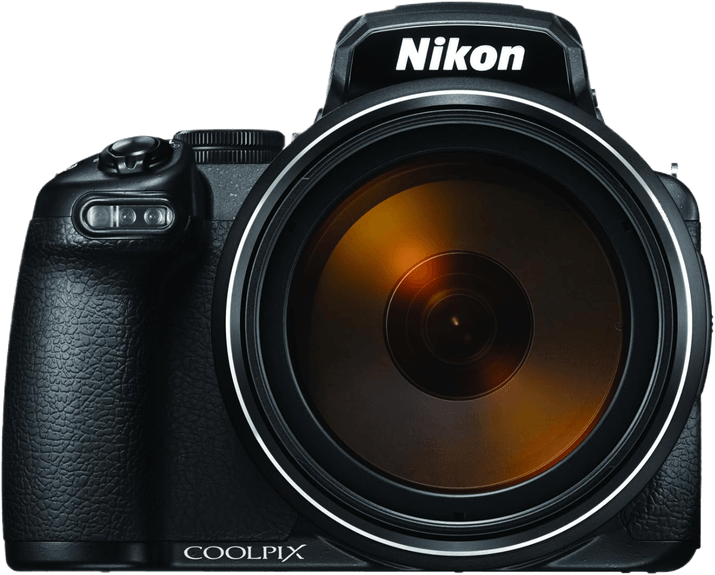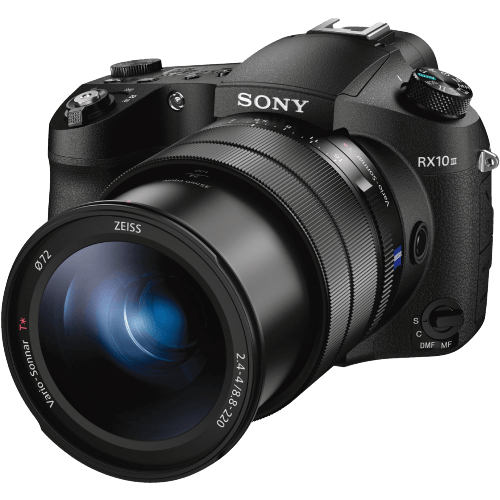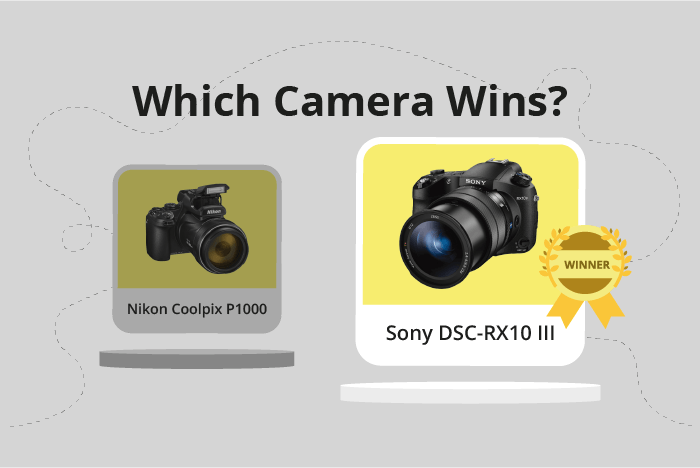Nikon Coolpix P1000 vs Sony Cyber-shot DSC-RX10 III Comparison
Nikon Coolpix P1000

Sony Cyber-shot DSC-RX10 III

The Sony Cyber-shot DSC-RX10 III outperforms the Nikon Coolpix P1000 with a score of 63/100 compared to 52/100. Both cameras are bridge types, released in 2016 and 2018, with launch prices of $1499 and $999.95, respectively. They share similar specifications, but the Sony RX10 III has a few advantages.
The Sony RX10 III is more compact and lighter, measuring 133 x 94 x 127mm and weighing 1051g, whereas the Nikon P1000 measures 146 x 119 x 181mm and weighs 1415g. This makes the Sony RX10 III more portable and convenient for travel or prolonged use.
However, the Nikon P1000 has a lower launch price, making it more budget-friendly for those looking for a capable camera without breaking the bank.
Taking these points into account, the Sony RX10 III is the superior choice for its compact size and lighter weight, while the Nikon P1000 is a more affordable option for those on a tighter budget.
Nikon Coolpix P1000 vs Sony Cyber-shot DSC-RX10 III Overview and Optics
The Sony Cyber-shot DSC-RX10 III emerges as the winner in the optics comparison with a score of 63/100, while the Nikon Coolpix P1000 scores 53/100. Both cameras share some common specifications, such as having a CMOS sensor, a fixed lens mount, and image stabilization. However, there are notable differences that contribute to the Sony’s higher score.
The Sony RX10 III has a higher resolution with 20 megapixels, compared to the Nikon P1000’s 16 megapixels. This means the Sony camera can capture more detail in images. Additionally, the Sony has a faster shooting speed at 14 frames per second, doubling the Nikon’s 7 frames per second. This allows users to capture fast-moving subjects more effectively. The Sony camera also has a slightly better DXOMARK sensor score of 70, compared to the Nikon’s score of 69.
On the other hand, the Nikon P1000 does have some advantages, such as a larger sensor size (1/2.3″) compared to the Sony’s 1″ sensor. This allows for better low-light performance and a shallower depth of field. However, this advantage is not significant enough to outweigh the benefits offered by the Sony RX10 III.
In terms of processors, the Sony uses a Bionz X processor, while the Nikon uses an Expeed processor. The Sony’s processor contributes to its faster shooting speed and better image quality. Lastly, the Sony RX10 III has a 3:2 aspect ratio, while the Nikon P1000 has a 4:3 aspect ratio. The 3:2 aspect ratio is more suitable for landscape photography and printing, whereas the 4:3 ratio is more suitable for display on electronic devices.
Considering the aforementioned points, the Sony Cyber-shot DSC-RX10 III outperforms the Nikon Coolpix P1000 in terms of optics, making it the better choice for photographers seeking superior image quality and faster shooting speeds.
Nikon Coolpix P1000 vs Sony Cyber-shot DSC-RX10 III Video Performance
The Nikon Coolpix P1000 outperforms the Sony Cyber-shot DSC-RX10 III in video capabilities, scoring 83/100 compared to Sony’s 64/100. Both cameras share some common specifications, such as the maximum video frame rate and built-in time-lapse functionality. However, the Nikon P1000 excels in certain areas, while the Sony RX10 III has its own advantages.
One of the main reasons the Nikon P1000 surpasses the Sony RX10 III is its maximum video resolution of 4K (3840 x 2160), which is significantly higher than Sony’s Full HD (1920 x 1080) resolution. This difference allows the P1000 to capture more detailed and sharper videos, making it a better choice for those who prioritize video quality.
The Sony RX10 III, on the other hand, offers a higher maximum video frame rate of 120fps, compared to the P1000’s 60fps. This advantage allows the RX10 III to capture smoother slow-motion videos, which can be an essential feature for some users.
Despite its lower video score, the Sony RX10 III does not have built-in time-lapse functionality, which can be a disadvantage for those who enjoy creating time-lapse videos. This feature is present in the Nikon P1000, making it a more versatile option for video enthusiasts.
Considering these factors, the Nikon Coolpix P1000 is the better choice for users seeking higher video resolution and built-in time-lapse functionality. However, the Sony Cyber-shot DSC-RX10 III may be more suitable for those who prioritize slow-motion capture due to its higher maximum video frame rate.
Nikon Coolpix P1000 vs Sony Cyber-shot DSC-RX10 III Features and Benefits
The Sony Cyber-shot DSC-RX10 III outperforms the Nikon Coolpix P1000 in features, scoring 70 out of 100 compared to the P1000’s 57. Both cameras share some common specifications, such as flip screens, no GPS, and WiFi connectivity.
The RX10 III excels in screen resolution, offering 1,228,800 dots compared to the P1000’s 921,600 dots. This higher resolution provides a clearer and more detailed image preview. Additionally, the RX10 III includes a touchscreen, making it easier to navigate menus and adjust settings quickly.
On the other hand, the P1000 has a larger screen size at 3.2 inches compared to the RX10 III’s 3 inches. This difference may provide a slightly better viewing experience for users. The P1000 also features Bluetooth connectivity, which the RX10 III lacks. This allows for easier and more convenient file transfers and remote control capabilities.
Despite these advantages, the P1000’s lower overall feature score indicates that the RX10 III is the superior camera in terms of features. The RX10 III’s higher screen resolution and touchscreen capabilities provide a more user-friendly experience, while the P1000’s larger screen size and Bluetooth connectivity do not outweigh the benefits of the RX10 III.
In comparing the two cameras, it is evident that the Sony Cyber-shot DSC-RX10 III offers better features than the Nikon Coolpix P1000. Users may find the RX10 III to be a more versatile and user-friendly option, making it the preferred choice for those seeking a camera with superior features.
Nikon Coolpix P1000 vs Sony Cyber-shot DSC-RX10 III Storage and Battery
The Nikon Coolpix P1000 outperforms the Sony Cyber-shot DSC-RX10 III in storage and battery with a score of 29/100 compared to Sony’s 24/100. Both cameras have one memory card slot, and they both accept SD, SDHC, and SDXC cards. However, the Sony camera also accepts Memory Stick Duo, Pro Duo, and Pro-HG Duo cards, offering more storage options.
Nikon’s P1000 has a shorter battery life of 250 shots, while the Sony RX10 III can take 420 shots on a single charge. Despite this, the P1000 has an advantage in having USB charging, which the Sony RX10 III lacks. This feature allows for more convenient charging options for the Nikon camera.
In terms of storage and battery, the Nikon Coolpix P1000 takes the lead with USB charging, although it has a shorter battery life. On the other hand, the Sony Cyber-shot DSC-RX10 III offers more storage options and a longer battery life, but lacks USB charging.
Nikon Coolpix P1000 vs Sony Cyber-shot DSC-RX10 III – Our Verdict
Are you still undecided about which camera is right for you? Have a look at these popular comparisons that feature the Nikon Coolpix P1000 or the Sony Cyber-shot DSC-RX10 III:
- Nikon Coolpix P1000 vs Coolpix P950
- Nikon Coolpix P1000 vs Sony Cyber-shot RX10 IV
- Sony Cyber-shot DSC-RX10 III vs Cyber-shot RX10 IV
- Canon EOS 50D vs Nikon Coolpix P1000
- Panasonic Lumix DMC-FZ2000 / FZ2500 vs Sony Cyber-shot DSC-RX10 III
- Panasonic Lumix FZ300 / FZ330 vs Sony Cyber-shot DSC-RX10 III

